Table of Contents
What is data bias?
Data bias is the systematic error introduced into data workflows and machine learning (ML) models due to inaccurate, missing, or incorrect data points which fail to accurately represent the population. Data bias in AI systems can lead to poor decision-making, costly compliance issues as well as drastic societal consequences. Amazon’s gender-biased HR model and Google’s racially-biased hate speech detector are some well-known examples of data bias with significant repercussions in the real world. It is no surprise, then, that 54% of top-level business leaders in the AI industry say they are “very to extremely concerned about data bias”.
With the massive new wave of interest and investment in Large Language Models (LLMs) and Generative AI, it is crucial to understand how data bias can affect the quality of these applications and the strategies you can use to mitigate this problem.
In this article, we will dive into the nuances of data bias. You will learn all about the different types of data bias, explore real-world examples involving LLMs and Generative AI applications, and learn about effective strategies for mitigation and the crucial role of synthetic data.
Data bias types and examples
There are many different types of data bias that you will want to watch out for in your LLM or Generative AI projects. This comprehensive Wikipedia list contains over 100 different types, each covering a very particular instance of biased data. For this discussion, we will focus on 5 types of data bias that are highly relevant to LLMs and Generative AI applications.
- Selection bias
- Automation bias
- Temporal bias
- Implicit bias
- Social bias
Selection bias

Selection bias occurs when the data used for training a machine learning model is not representative of the population it is intended to generalize to. This means that certain groups or types of data are either overrepresented or underrepresented, leading the model to learn patterns that may not accurately reflect the broader population. There are many different kinds of selection bias, such as sampling bias, participation bias and coverage bias.
Example: Google’s hate-speech detection algorithm Perspective is reported to exhibit bias against black American speech patterns, among other groups. Because the training data did not include sufficient examples of the linguistic patterns typical of the black American community, the model ended up flagging common slang used by black Americans as toxic. Leading generative AI companies like OpenAI, Anthropic and others are using Perspective daily at massive scale to determine the toxicity of their LLMs, potentially perpetuating these biased predictions.
Solution: Invest in high-quality, diverse data sources. When your data still has missing values or imbalanced categories, consider using synthetic data with rebalancing and smart imputation methods.
Automation bias

Automation bias is the tendency to favor results generated by automated systems over those generated by non-automated systems, irrespective of the relative quality of their outputs. This is becoming an increasingly relevant type of bias to watch out for as people, including top-level business leaders, may rush to implement automatically generated AI applications with the underlying assumption that simply because these applications use the latest, most popular tech their output will be inherently more trustworthy or performant.
Example: In a somewhat ironic overlap of generative technologies, a 2023 study found that some Mechanical Turk workers were using LLMs to generate the data which they were being paid to generate themselves. Later studies have since shown that training generative models on generated data can create a negative loop, also called “the curse of recursion”, which can significantly reduce output quality.
Solution: Include human supervision safeguards in any mission-critical AI application.
Temporal or historical bias
Temporal or historical bias arises when the training data is not representative of the current context in terms of time. Imagine a language model trained on a dataset from a specific time period, adopting outdated language or perspectives. This temporal bias can limit the model's ability to generate content that aligns with current information.

Example: ChatGPT’s long-standing September 2021 cut-off date is a clear example of a temporal bias that we have probably all encountered. Until recently, the LLM could not access training data after this date, severely limiting its applicability for use cases that required up-to-date data. Fortunately, in most cases the LLM was aware of its own bias and communicated it clearly with responses like "'I'm sorry, but I cannot provide real-time information".
Solution: Invest in high-quality data, up-to-date data sources. If you are still lacking data records, it may be possible to simulate them using synthetic data’s conditional generation feature.
Implicit bias
Implicit bias can happen when the humans involved in ML building or testing operate based on unconscious assumptions or preexisting judgments that do not accurately match the real world. Implicit biases are typically ingrained in individuals based on societal and cultural influences and can impact perceptions and behaviors without conscious awareness. Implicit biases operate involuntarily and can influence judgments and actions even when an individual consciously holds no biased beliefs. Because of the implied nature of this bias, it is a particularly challenging type of bias to address.

Example: LLMs and generative AI applications require huge amounts of labeled data. This labeling or annotation is largely done by human workers. These workers may operate with implicit biases. For example, in assigning a toxicity score for specific language prompts, a human annotation worker may assign an overly cautious or liberal score depending on personal experiences related to that specific word or phrase.
Solution: Invest in fairness and data bias training for your team. Whenever possible, involve multiple, diverse individuals in important data processing tasks to balance possible implicit biases.
Social bias
Social bias occurs when machine learning models reinforce existing social stereotypes present in the training data, such as negative racial, gender or age-dependent biases. Generative AI applications can inadvertently perpetuate biased views if their training data includes data that reflects societal prejudices. This can result in responses that reinforce harmful societal narratives. As ex-Google researcher Timit Gebru and colleagues cautioned in their 2021 paper: “In accepting large amounts of web text as ‘representative’ of ‘all’ of humanity [LLMs] risk perpetuating dominant viewpoints, increasing power imbalances and further reifying inequality.”
Example: Stable Diffusion and other generative AI models have been reported to exhibit socially biased behavior due to the quality of their training datasets. One study reported that the platform tends to underrepresent women in images of high-performing occupations and overrepresent darker-skinned people in images of low-wage workers and criminals. Part of the problem here seems to be the size of the training data. Generative AI models require massive amounts of training data and in order to achieve this data volume, the selection controls are often relaxed leading to poorer quality (i.e. more biased) input data.

Solution: Invest in high-quality, diverse data sources as well as data bias training for your team. It may also be possible to build automated safeguarding checks that will spot social bias in model outputs.
Perhaps more than any other type of data bias, social bias shows us the importance of the quality of the data you start with. You may build the perfect generative AI model but if your training data contains implicit social biases (simply because these biases existed in the subjects who generated the data) then your final model will most likely reproduce or even amplify these biases. For this reason, it’s crucial to invest in high-quality training data that is fair and unbiased.
Strategies for reducing data bias
Recognizing and acknowledging data bias is of course just the first step. Once you have identified data bias in your project you will also want to take concrete action to mitigate it. Sometimes, identifying data bias while your project is ongoing is already too late; for this reason it’s important to consider preventive strategies as well.
To mitigate data bias in the complex landscape of AI applications, consider:
- Investing in dataset diversity and data collection quality assurances.
- Performing regular algorithmic auditing to identify and rectify bias.
- Including humans in the loop for supervision.
- Investing in model explainability and transparency.
Let’s dive into more detail for each strategy.
Diverse dataset curation
There is no way around the old adage: “garbage in, garbage out”. Because of this, the cornerstone of combating bias is curating high-quality, diverse datasets. In the case of LLMs, this involves exposing the model to a wide array of linguistic styles, contexts, and cultural nuances. For Generative AI models more generally, it means ensuring to the best of your ability that training data sets are sourced from as varied a population as possible and actively working to identify and rectify any implicit social biases. If, after this, your data still has missing values or imbalanced categories, consider using synthetic data with rebalancing and smart imputation methods.
Algorithmic auditing
Regular audits of machine learning algorithms are crucial for identifying and rectifying bias. For both LLMs and generative AI applications in general, auditing involves continuous monitoring of model outputs for potential biases and adjusting the training data and/or the model’s architecture accordingly.
Humans in the loop
When combating data bias it is ironically easy to fall into the trap of automation bias by letting programs do all the work and trusting them blindly to recognize bias when it occurs. This is the core of the problem with the widespread use of Google’s Perspective to avoid toxic LLM output. Because the bias-detector in this case is not fool-proof, its application is not straightforward. This is why the builders of Perspective strongly recommend continuing to include human supervision in the loop.
Explainability and transparency
Some degree of data bias is unavoidable. For this reason, it is crucial to invest in the explainability and transparency of your LLMs and Generative AI models. For LLMs, providing explanations and sources for generated text can offer insights into the model's decision-making process. When done right, model explainability and transparency will give users more context on the generated output and allow them to understand and potentially contest biased outputs.
Synthetic data reduces data bias
Synthetic data can help you mitigate data bias. During the data synthesization process, it is possible to introduce different kinds of constraints, such as fairness. The result is fair synthetic data, without any bias. You can also use synthetic data to improve model explainability and transparency by removing privacy concerns and significantly expanding the group of users you can share the training data with.


More specifically, you can mitigate the following types of data bias using synthetic data:
Selection Bias
If you are dealing with imbalanced datasets due to selection bias, you can use synthetic data to rebalance your datasets to include more samples of the minority population. For example, you can use this feature to provide more nuanced responses for polarizing topics (e.g. book reviews, which generally tend to be overly positive or negative) to train your LLM app.
Social Bias
Conditional data generation enables you to take a gender- or racially-biased dataset and simulate what it would look like without the biases included. For example, you can simulate what the UCI Adult Income dataset would look like without a gender income gap. This can be a powerful tool in combating social biases.
Reporting or Participation Bias
If you are dealing with missing data points due to reporting or participation bias, you can use smart imputation to impute the missing values in a high-quality, statistically representative manner. This allows you to avoid data loss by allowing you to use all the records available. Using MOSTLY AI’s Smart Imputation feature it is possible to recover the original population distribution which means you can continue to use the dataset as if there were no missing values to begin with.
Mitigating data bias in LLM and generative AI applications
Data bias is a pervasive and multi-faceted problem that can have significant negative impacts if not dealt with appropriately. The real-world examples you have seen in this article show clearly that even the biggest players in the field of AI struggle to get this right. With tightening government regulations and increasing social pressure to ensure fair and responsible AI applications, the urgency to identify and rectify data bias at all points of the LLM and Generative AI lifecycle is only becoming stronger.
In this article you have learned how to recognise the different kinds of data bias that can affect your LLM or Generative AI applications. You have explored the impact of data bias through real-world examples and learned about some of the most effective strategies for mitigating data bias. You have also seen the role synthetic data can play in addressing this problem.
If you’d like to put this new knowledge to use directly, take a look at our hands-on coding tutorials on conditional data generation, rebalancing, and smart imputation. MOSTLY AI's free, state-of-the-art synthetic data generator allows you to try these advanced data augmentation techniques without the need to code.
For a more in-depth study on the importance of fairness in AI and the role that synthetic data can play, read our series on fair synthetic data.
MOSTLY AI has recently been mentioned in an excellent article about synthetic data by the MIT Technology Review. We are honored to have been featured and would like to elaborate on some topics Karen Hao, the renowned AI journalist, raised.
On synthetic data's potential for fair AI
As the article states, extrapolating new data from an existing data set indeed reproduces the biases embedded in the original. However, it is possible to augment the data to make it fairer via synthetization. For example, our team fixed the racial bias in the infamous Compas recidivism data set and reduced the racial difference in the data from 24% to a mere 1% by introducing demographic parity through the synthetization process. Thus, our research proves that it is indeed possible to synthesize near bias-free versions of your data.
According to Christo Wilson, an associate professor of computer science at Northeastern University, perfectly balanced data sets don't automatically translate into perfectly fair AI systems. They don't. That is exactly why you need synthetic data. Simply upping subject numbers for minorities or removing sensitive categories like race does not solve the issue. Synthetization, on the other hand, is capable of fixing biases in a holistic way, regenerating data to reflect reality not as it is but as we would like to see it.
As long as you are aware of your biases and your definition of fairness is solid and fits the specific case you are looking at, you can create a data set that satisfies these constraints. If you are curious and would like to know more, check out our fair synthetic data research poster presented at the ICLR 2021 machine learning conference!
Synthetic data for explainable AI
The article quotes one of our favorite ethical AI activists, Cathy O'Neil: 'As regulators confront the need to test AI systems for legal compliance, it could be the only approach that gives them the flexibility they need to generate on-demand, targeted testing data.' Indeed, the role of synthetic data is about to become even more pronounced with the upcoming AI regulations looming over Europe and elsewhere. Synthetic data can provide local interpretability to AI systems, essentially functioning as a window into the workings of an algorithm. If you are curious about how synthetic data can power explainable AI in practical terms, check out our recent synthetic data for XAI manifesto!
To the future of synthetic data and beyond
Cathy O'Neil says, 'Synthetic data is likely to get better over time, but not by accident.' We couldn't agree more, and our world-class team of scientists and engineers is constantly working on just that. If you would like to be there when synthetic data breakthroughs happen, sign up for the MOSTLY AI newsletter!
Last year MOSTLY AI has introduced and demonstrated the groundbreaking idea of generating fair synthetic data. I.e., data, that is representative of the real world, but that has unwanted biases, unwanted relations, surgically removed from it at the same time. Machine learning models that are then trained on fair synthetic data will be fair by design. It’s a thought-provoking paradigm shift, that will allow organizations to govern not only Privacy but also Fairness within AI at its source, that is the AI training data itself.
Fast forward to today, we are excited to see many things happening around fairness:
- The broad public interest in fairness and AI bias has drastically picked up, resulting in media coverage, documentaries, books, public debates, analyst reports, etc.
- The regulators are becoming active, with most notably the European Commission proposing an AI regulation, that explicitly demands that training data shall be fair & representative. US regulators are expected to follow suit, particularly within high-risk domains, like finance and health care.
- Leading AI conferences, like the ICLR, expand beyond accuracy and dedicate workshops to ethics, like Responsible AI or Synthetic Data for Privacy.
Speaking of ICLR, we had the honor to present our work on fair synthetic data at this year’s conference. This is another recognition of our work, which was already featured by Andrew Ng, IEEE Spectrum, Forbes, Slate, and many more. While the corresponding research paper is now available on arxiv.org, and the Fair Synthetic Data poster is accessible here, we summarize the key take aways once more:
- MOSTLY AI’s technology allows to generate Synthetic Data that is both statistical representative as well as fair - in the sense that it adheres to provided fairness constraints
- The trade-off between representativeness and fairness can be explicitly controlled for.
- Hidden proxy variables (e.g., body height serving as proxy for gender, or ZIP codes for race), which pose a significant challenge in combating biases, are successfully controlled for.
- And fairness can be established while only marginally impacting the downstream machine learning utility. One thus does not need to compromise significantly on accuracy in the pursuit of Ethical AI. Find out how to create fair synthetic data from our earlier blog post!
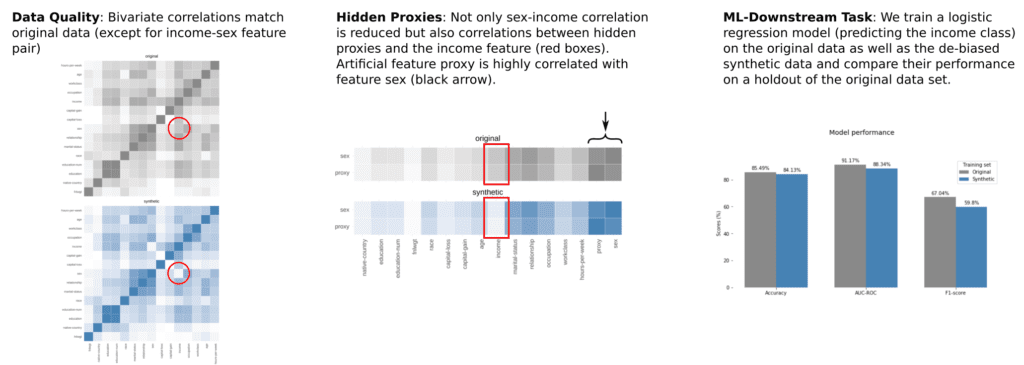
Last but not least, and as further testimony to the validity of the approach, Amazon just published a paper on fast fair synthetic data as well. And as their study leverages the same US census data as our paper, it allows for a direct comparison of results. We always knew that the quality of our synthetic data is unparalleled, but even we were amazed to see the effectiveness of our approach, as we excel on every single available dimension of realism, accuracy, as well as fairness:
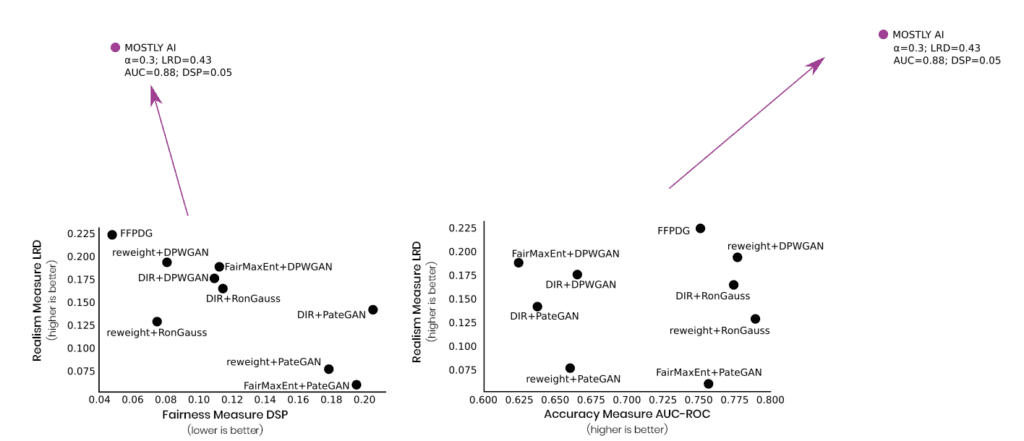
So, if Ethical AI is a priority for your organization or you deploy AI algorithms that directly impact the lives of individuals, then talk to us, and let’s discuss how we can get you started with fair synthetic data today. If you would like to learn more about fair synthetic data, read our Fairness Series!
Co-Authors: Alexandra Ebert & Daniel Soukup
In the previous part of this series, we have discussed two risks entailed in the rise of digitalization and artificial intelligence: the violation of the privacy and fairness of individuals. We have also outlined our approach to mitigate privacy and fairness risks with bias-corrected synthetic data: this allows for privacy-preserving data sharing and also aids the fair treatment of customers (data subjects) in downstream analysis and machine-learning tasks. (By the way, if you would like to experiment with fair synthetic data yourself, you can download the datasets we created at the bottom of the page.)
If you would like to dig deeper into algorithmic fairness and the potential risks in machine learning systems, we can highly recommend The Ethical Algorithm book by M. Kearns and A. Roth. For a more technical viewpoint, check out fairmlbook.org to find lecture notes, videos, and other great resources.
In this blog post, we take a deeper dive into our approach to de-bias synthetic data. For now, we focus on statistical parity as a fairness measure and show in detail the effects of our approach in two settings:
- the Adult US census data set, which is an extract of the 1994 US Census database, and
- the Compas recidivism data set that was the focus of ProPublica’s high profile machine bias study.
Read the other parts of the series:
- Part 1 - Why Bias in AI is a Problem & Why Business Leaders Should Care
- Part 2 - 10 Reasons For Bias In AI And What To Do About It
- Part 3 - We Want Fair AI Algorithms – But How To Define Fairness?
- Part 4 - Tackling AI Bias At Its Source – With Fair Synthetic Data
Statistical Parity as a Measure of Fairness
Let’s start with a quick reminder: a data set or algorithm being unfair usually refers to some kind of imbalance. A rather intuitive measure for such an imbalance is the so-called statistical or demographic parity. In mathematical terms, we can describe it as follows: consider a population that can be split into groups by a sensitive attribute S, such as gender, skin color, age or any other property. Then consider another target attribute T that contains sensitive information on the population such as income, whether or not people spent time in prison or credit history.
In the Adult data set, we select the sensitive attribute (S) gender, either “female” or “male”, and the target attribute (T) income, which is either “>50k” or “<=50k”.

In this example, statistical parity is satisfied when the number of females that earn more than 50K divided by the total count of females equals the number of males earning more than 50K divided by the total number of males:

In other words, the probability that a randomly chosen male is a high earner should be the same as the probability of a random female being a high earner. Also, note that when these two fractions are equal for the high-income segment (“>50K”) then this automatically holds true for the low-income segment (“<=50K”) as well.
In the real world, unfortunately, the equality above does not hold true. A simple visualization of the data set reveals a strong imbalance between females and males (Fig 2).
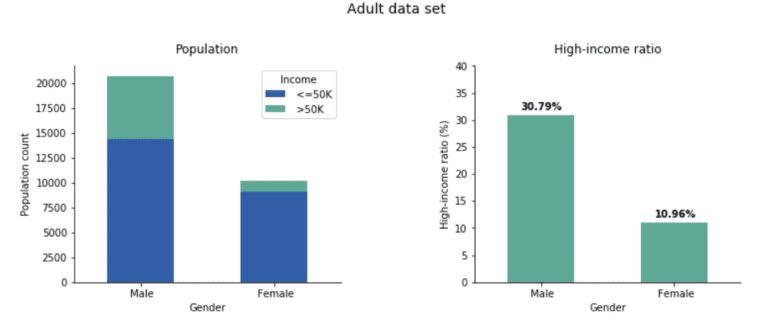
Only 10.96% of women are in the high-income range while among men, the fraction is 30.79%, almost three times higher. In the remainder of the blog post, we show how to create a fair, synthetic version of the Adult data set that removes the income gap between these two gender groups.
Though being intuitive, parity has limitations especially in the context of fair algorithmic decision making. We are aware of these shortcomings, some of which we mentioned in our fairness definitions post already, and we will discuss alternative fairness measures at the end of this blog post.
Generating a Fair Dataset
One of the first ideas to try when creating a fair data set for machine learning is to drop the sensitive column. In the presented case that’s the “sex” attribute. At first sight, this sounds like a good and easy-to-implement solution but, unfortunately, it can actually cause more harm than good. On one hand, what makes this approach fail can be so-called proxy or hidden proxy columns. Imagine we know which neighborhood a person lives in, the brand and model of the person’s mobile phone, the car this person drives, where this person buys her/his clothes, etc. Given some of the above information, we humans can make a pretty educated guess on this person’s sex, skin color, and other attributes. And since algorithms are better in analyzing patterns like this, they will definitely detect these correlations and exploit them, leading again to unfair predictions and decisions. We could actually go one step further and say that leaving the “sex” column in the data set is better for fairness because it offers a clear handle to enforce fairness constraints such as statistical parity. To give another example from criminal justice, women on average are less likely to commit future violent crimes than men with similar criminal records. So, a gender-neutral assessment can overestimate a woman’s recidivism risk.
Our synthetic data platform's community version is free to use and leverages deep neural networks to produce synthetic data. In order to generate fair synthetic data, we add a fairness constraint to the model parameter optimization during training. Sticking with the Adult data set, we penalize the violation of statistical parity within every mini-batch by increasing the training loss by a number that is proportional to the difference between the fraction of women and the fraction of men in the high-income segment. A very similar approach for training fair classifiers is described in a paper by P. Manisha and S. Gujar and an implementation can be found at Y. Shavit’s github repo.
In more general terms, adding the fairness constraint expands the objective of our software from generating accurate and private synthetic data to generating accurate, private, and fair synthetic data.
Private and Fair Synthetic Data
After feeding the Adult data set to our software and training it with the additional parity fairness constraint in place, we generate a synthetic fair version of the Adult data set. Once we evaluate the income distribution, we see a major change: the income gap almost disappeared (Fig 3).
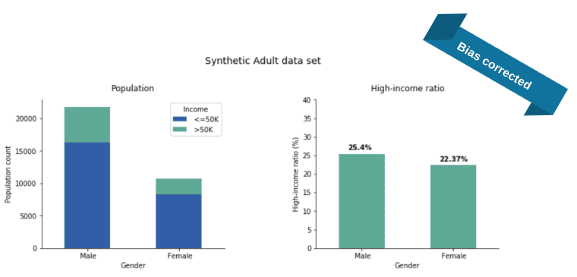
Actually, we repeated the whole process 50 times and the plotted numbers are the average ratios over these independent runs. The income-ratios slightly varied across the 50 experiments but this variance (rooted in the stochastic nature of our training and generation process) was quite small: 1.2% and 1.3% for the Male and Female ratios, respectively. As apparent from the plots, the synthesis corrected the income gap: 25% of the synthetic males are high earners (instead of the real 30%) and 22% of the synthetic females are high earners (while the original value was 11% only).
With regards to parity, it is common to compare not just the difference but the fraction of high-income male ratio to high-income female ratio (that is, we divide the two sides of the above equation). This fraction is called the disparate impact and it is an industry-standard to ask for at least 0.8, the so-called four-fifth rule. In the original data set, this fraction is roughly 10/30 = 0.33, a quite severe disparate impact violation but the bias-corrected synthetic data is at 22/25 = 0.88, well over the threshold.
The additional parity constraint during model training does not diminish the quality and accuracy of the synthetic data. Univariate distributions of the synthetic-data attributes almost perfectly match their original counterparts (in Figure 4, we show only a selection). Please note that, while parity is modified to a large degree, both the population-wide male-to-female ratio, as well as the high-earner-to-low-earner ratios, are preserved.
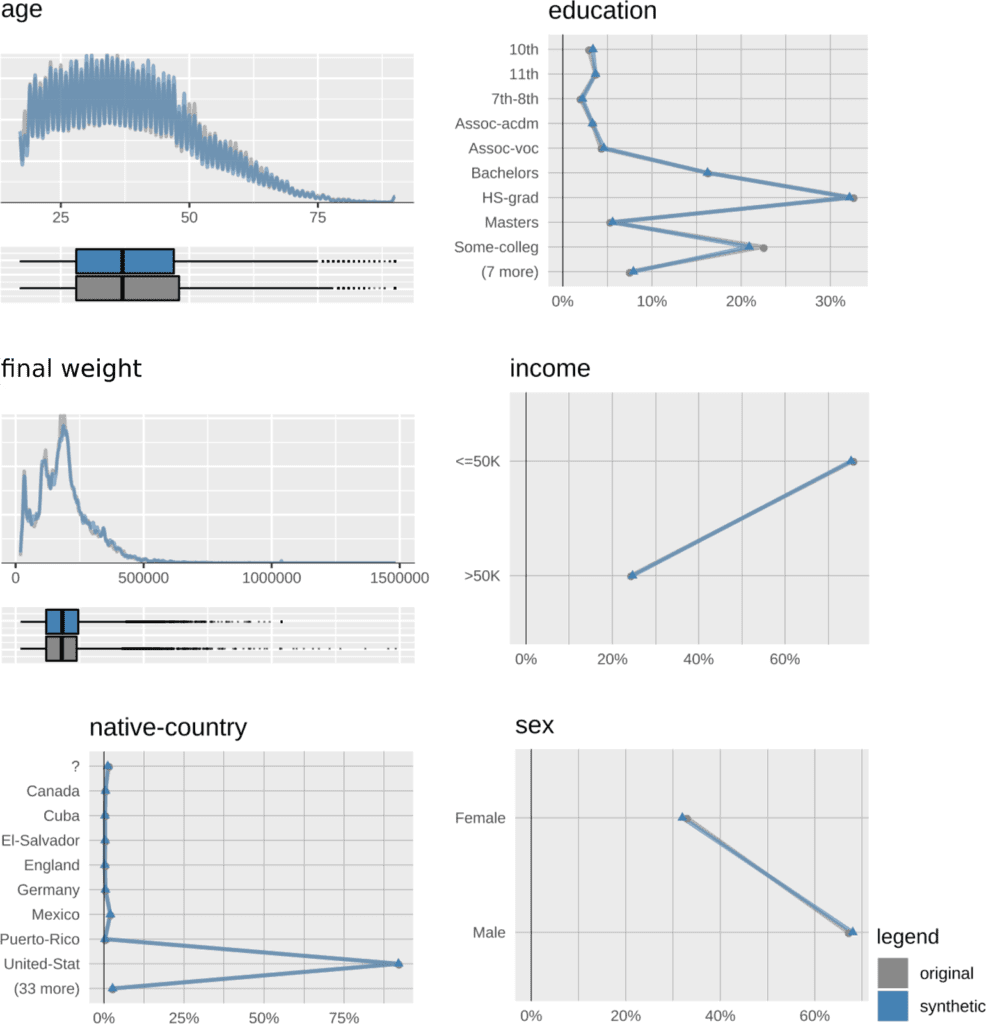
Also the bivariate correlations of the synthetic data, on first sight, seem to be in excellent agreement with the original data (Figure 5).

A closer look, however, reveals some detailed changes due to the inner workings of the fairness constraint. Given the statistical parity definition, “income” must not depend on “sex”, which means these two attributes should not be correlated.
While in the original data, there is a clear “sex”-”income” correlation (red circle in the left plot in Figure 5) this dependency is almost reduced to noise level in the fair, synthetic data (red circle in the right plot in Figure 5). Apart from the “sex”-”income” pair, no other correlation seems to be altered by applying the fairness constraint, at least not strong enough to show a visible effect on the correlation plot.
But what about proxy attributes, columns in the data set that are correlated with “sex” and “income”? Can they introduce unfairness through a backdoor, as they are not explicitly mentioned in the parity constraint? Recall that the “parity equation” (see Equation 1) contains the attributes “sex” and “income” only.
To visualize the effect of the parity constraint on proxy attributes, we add an artificial feature to the Adult data set named “proxy”. We generated this column so that it is strongly correlated with the attribute “sex”. For females, “proxy” equals to 1 in 90% of all cases and equals to 0 for the remaining 10%. For males, the percentages are swapped. Looking at this new data set, we see, first, the strong correlation between “sex” and “proxy” (the black arrow on the left-hand side plot of Figure 6). Second, as these two attributes are strongly linked, also their correlation to “income” is comparable (the red arrow on the left-hand side plot of Figure 6). Now, when we run our synthetic data solution with the fairness constraint in place on “sex” only, we find that in the fair synthetic data both correlations “sex”-”income” and “proxy”-”income” are almost reduced to noise level (the red arrow on the right-hand side plot of Figure 6). The latter finding shows that the parity constraint works as intended and accounts for (hidden) proxy attributes.

In the Adult data set, gender is not the only sensitive attribute: if we train our synthetic engine with “race” as a sensitive attribute, we get similarly impressive corrections (for this task, we used a simplified version of the data set filtering for Black/White subjects). In the original data, there are twice as many high earners in the White population than in the African American, but the ratios are almost exactly equal in our adjusted synthetic data (Figure 7).
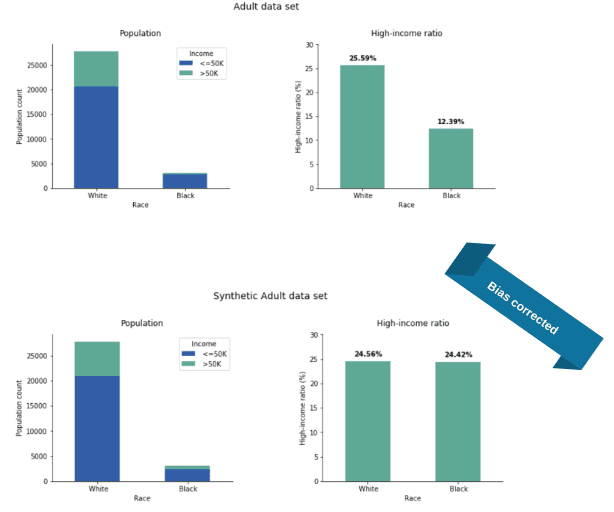
In summary, the introduction of (parity) fairness to our software solution shows very promising results. The quality and accuracy of the synthetic data remain high, the privacy of data subjects is protected, and parity-fairness is guaranteed. All these properties make private and fair synthetic data readily available for further application.
Mitigating Bias on More Than One Feature
It is also a possibility to turn on the fairness loss on multiple sensitive attributes at the same time which we did for race and gender. In this case, one must be careful what ratios to optimize: if we were to simply put fairness losses independently on race and gender then the algorithm might fall into the mistake of “fairness gerrymandering”. That is, the new data set would look fair with respect to both gender and race individually, but we would see high imbalances when restricted to gender and race simultaneously (Figure 8).

Taking this into account, our solution gives synthetic data with significantly balanced high-income ratios across the four groups given by race and gender (Figure 9).
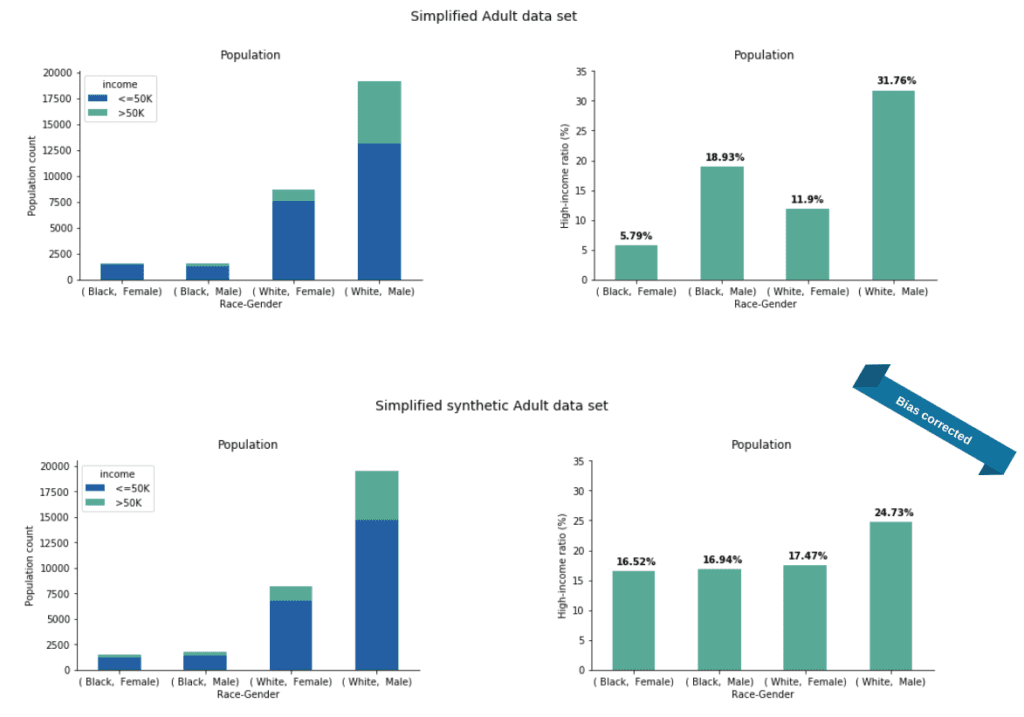
It is apparent that we did not achieve complete parity but this difference can be further lowered by giving higher weight to the fairness loss against the accuracy loss.
Fair Synthetic Data in Downstream Machine Learning Tasks
In the previous post, we introduced a scenario in which Got Big Data Company generates a fair synthetic dataset. This data set is handed to an external vendor, SmartUP AI, to develop new predictive models. As the data set is fair and synthetic, SmartUP AI does not need to take specific privacy measures nor does it need to apply any bias correction so they can work with standard, out-of-the-box models.
We demonstrate this with the Adult census data by fitting a simple linear model, logistic regression, which predicts the income level, high versus low, based on the other attributes. As we mentioned, there is no point in removing gender as an explanatory variable since the data set can contain other hidden proxies. We train two models, one on the original data set and one on the bias-corrected synthetic data. Both models are then tested on a holdout from the original data. Moreover, we repeated the model training procedure 50 times with independently generated synthetic data.
The charts in Figure 10 show the mean performance of the real and synthetic models over these experiments. The synthetically fitted models have very competitive performance and generalize well to the unseen real data. Also, we observed only minimal variance across the experiments (2%, 2% and 2.5% in Accuracy, AUC-ROC, and F1-score, respectively).
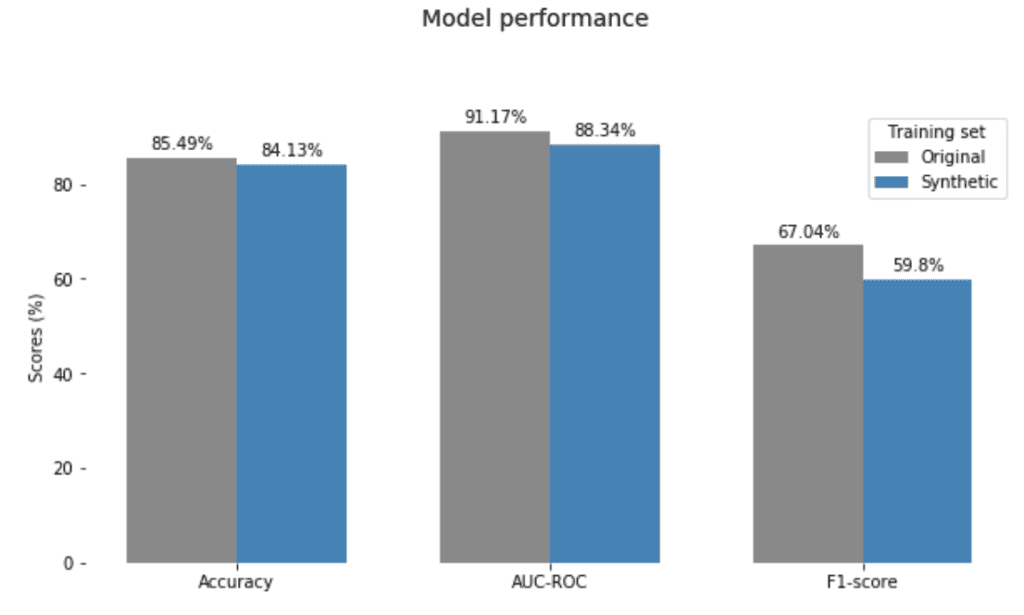
Moreover, the models trained on the synthetic data treat the classes of the sensitive attribute (gender, in this case) nearly equally. These predictive models output the probability of being high-income for any data point, so we can look at how these probabilities are distributed. Since there are more low-income samples, we expect these probabilities to be concentrated close to 0, both for females and males. However, for the model fitted on the original data, we see below that there is a much higher number of around-0 probabilities for females than males (Figure 11).
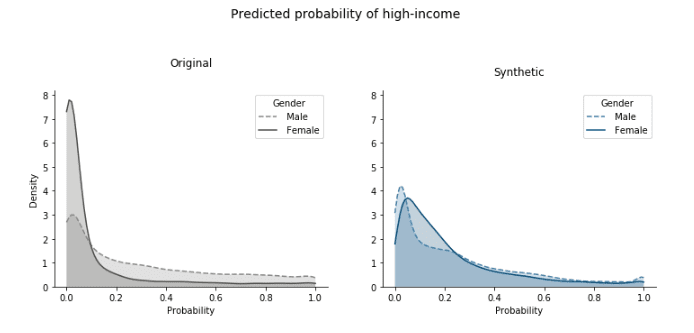
On the other hand, with the predictors trained on the synthetic data these distributions are brought very close together. This is exactly the group fairness that parity is designed to capture. The important thing to keep in mind though is that the predictive-model training itself did not involve any type of optimization to fairness and the evaluation is also on the biased original data. So this fair outcome is solely due to using bias-corrected synthetic data for the training.
Our results align with the findings of research conducted at Carnegie Mellon University into fair representations of data. We see that our fairness-constrained synthetic data solution learns to represent data points in a way that removes the dependencies between the sensitive and target attribute while preserving other relationships.
Correcting the Compas Data Set
We return briefly to the ProPublica study on algorithmic justice and the corresponding Compas data set (see our introductory fairness post). This data set contains information about defendants together with their predicted risk to re-offend, the so-called Compas score. We generate a parity-fair synthetic version of this data set with “race” as the sensitive attribute and the Compas score as the target variable. The original data set is heavily biased towards African Americans which in turn gets perfectly corrected in our synthetic data.
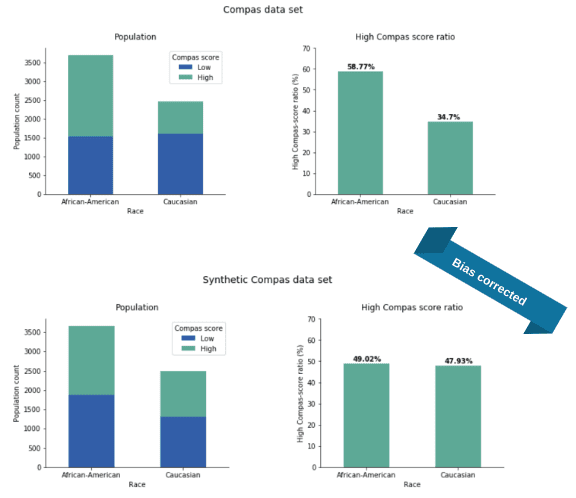
In the original Compas data set, the ratio of individuals with high Compas scores is 59% and 35% for African Americans and Caucasians, respectively. Quite impressively, our bias mitigated data reduced this gap to merely 1%, settling the values in the middle at 49% and 48%, respectively.
In the subsequent prediction task, we can achieve almost perfect equality between the predicted probabilities for high Compas score between the two classes of the sensitive attribute “race” (Figure 13).
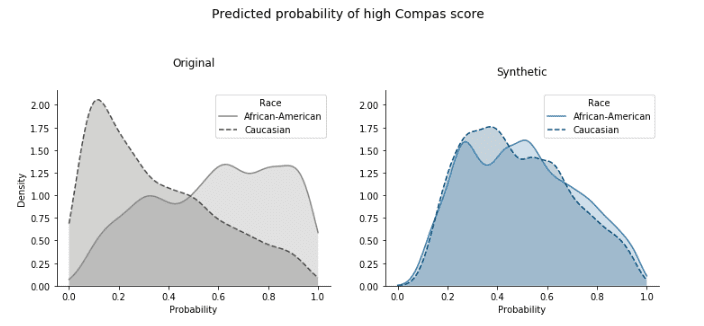
Looking at the classifier’s performance, this parity-correction comes with minimal compromise in predictive accuracy (Figure 14).
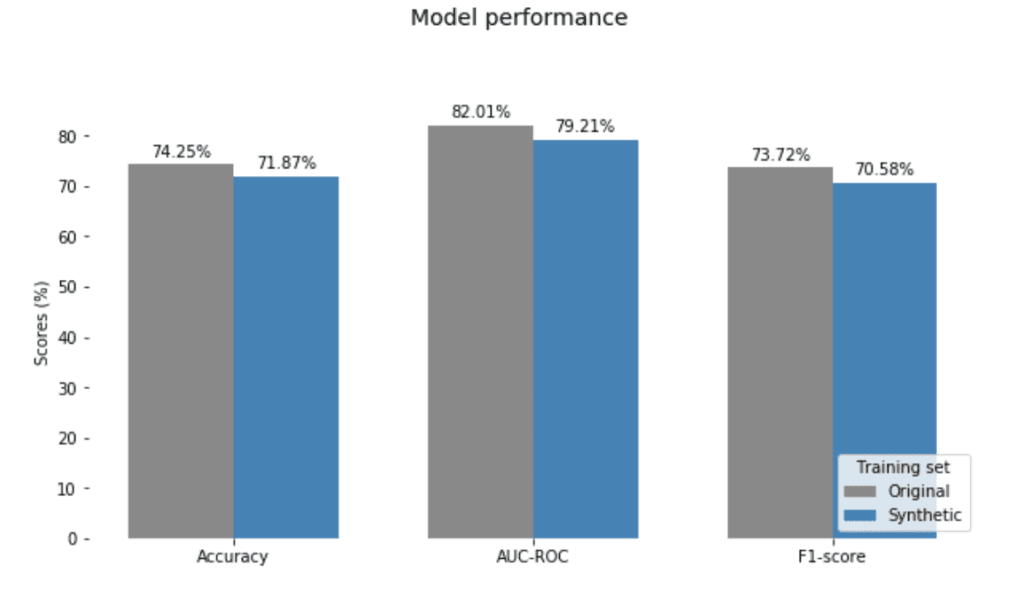
Alternative Fairness Definitions
While demographic parity is a very intuitive notion, it has certain limitations. As compared to other fairness definitions, there is a worse trade-off between satisfying parity and having high accuracy for the generated data. If your original data had a class imbalance then the parity-mitigated synthetic data or a classifier that is forced to satisfy parity cannot achieve the same level of accuracy as a predictor with no parity loss. Actually, the base-rate difference is a provable lower bound on the accuracy. Moreover, parity is a notion of group fairness, it equalizes outcomes across classes, while other approaches optimize for individual fairness focusing on treating similar individuals similarly. S. Corbett-Davies and S. Goel argue that all these approaches suffer from serious shortcomings and advocate a risk-based assessment that could better serve policymaking.
Since parity only considers the sensitive attribute and a single other variable, it is not designed to handle a situation involving both predictions and a ground-truth label (three variables all together). So, in a more nuanced approach to fairness, one aims to have a predictor model that makes the same mistakes with the same chance across the sensitive attribute classes.
Such notions include equal opportunity and equalized odds which we also tested in our synthesis process: our experiments showed that if we generate synthetic data sets with these fairness constraints then they also give rise to fair classifiers with respect to these stronger notions. We will share the details of these more technical results in a subsequent article.
Conclusions and How We Will Continue After #FairnessWeek
The notion of fairness (in particular, statistical parity) and synthetic data go together very well. Not only can we generate highly accurate synthetic data but we can also steer the generation to almost perfectly mitigate strong biases in the original data sets. The additional fairness constraint in the training loss of our generative models fine-tunes the correlation structure between attributes such that these biases are strongly reduced. Privacy and (parity) fairness are further preserved in downstream tasks: an out-of-the-box classifier model when trained on fair synthetic data makes fair predictions even on biased input.
Statistical parity has limitations, and, on a more general note, there is no concept of fairness or silver-bullet solution that is applicable to all possible use cases. While this was our last post of #FairnessWeek, we will definitely continue our work on fair synthetic data and mitigating bias in Artificial Intelligence. In an upcoming study, we will extend our approach to other fairness measures, such as equal false-positivity rate and equalized odds.
Co-Authors: Alexandra Ebert & Daniel Soukup
In the age of digitalization and the rise of artificial intelligence, more and more tasks in public and private organizations are managed or supported by computers and machine learning algorithms.
These include tasks such as data analysis, automated decision making, customer interaction services such as automated emails or chatbots, and recommendation systems. In general, we believe this is a good thing, as machine learning algorithms are fast, scalable, and can analyze way more complex data structures than humans. For example, there are studies showing that the adoption of automated underwriting in mortgage lending contributed to the increase of approval rates for minority and low-income applicants by 30% while improving the overall accuracy of default predictions.
However, machine learning algorithms typically require lots of training data and when this data contains sensitive information about real people, the stakes become extremely high. Two risks involve the violation of privacy and fairness: disclosing sensitive personal information and treating people unjustly during the decision-making process.
There are many well-documented cases of biased decision making that triggered an ongoing discussion about algorithmic fairness. A famous example is Google’s hate speech-detection algorithm that discriminated against African Americans. Researchers at the University of Washington found, that the algorithm was more likely to label their tweets as “hateful” or “offensive”. Not only was it biased against people of color, but also, as another study demonstrated, against well-known drag queens. Another case of bias in Artificial Intelligence was Amazon’s HR algorithm. The system was fed with 10 years worth of records of previous – and predominantly male – Amazon employees and thereby learned that being female poorly correlated with being a suitable candidate for a job at the tech company.
Now, in the cases above, algorithms systematically discriminate against a group based on its gender, race, or sexual orientation. If not addressed, these systemic biases end up in data sets that decision-making algorithms are trained on. Subsequently, the biased algorithms make unfair decisions, perpetuating, and actually amplifying the biases in our society.
We at MOSTLY AI believe in the positive powers of artificial intelligence to foster research and innovation. We will demonstrate that bias-corrected synthetic data can address both privacy and fairness concerns to allow for utilizing and democratizing big data assets while keeping the risks at a minimum. The current post will give a high-level overview of our work and in post 5 of our Fairness Series, we will discuss more technical aspects of our results as well as make our fair synthetic data sets available.
Read the other parts of the series:
- Part 1 - Why Bias in AI is a Problem & Why Business Leaders Should Care
- Part 2 - 10 Reasons For Bias In AI And What To Do About It
- Part 3 - We Want Fair AI Algorithms – But How To Define Fairness?
- Part 5 - Diving Deep Into Fair Synthetic Data Generation
From Privacy Protection To Promoting Fairness in AI
Our synthetic data platform, enables organizations to generate highly accurate, statistically representative synthetic data at scale such as synthetic customer records along with purchase histories. The software functions as an unlimited source of artificial individuals who have interacted with your business the same way as real people did historically. The synthetic data, however, can be shared safely without privacy concerns since these artificial people do not really exist and the privacy of your actual customers, the real data subjects, remains protected.
Synthetic data generation doesn’t need to stop at privacy protection though. As we generate the data from scratch, we can model and shape it to fit different needs. A beautiful example of this is NVIDIA’s styleGAN, where a conditional generation of synthetic images allows for adding smiles or sunglasses to faces, or changing hair and skin color.
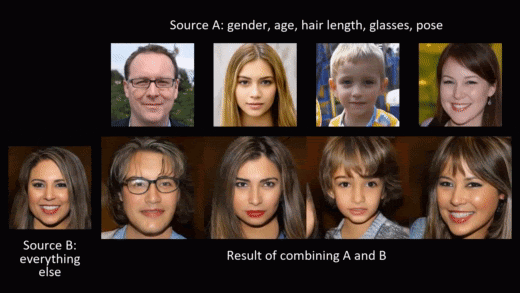
In this blog post, we want to leverage the possibility of modeling and shaping synthetic data to mitigate the second risk mentioned in the introduction: violation of fairness. The result is fair synthetic data that is fully anonymous and de-biased (in accordance with a specific fairness definition).
To Get Fair Synthetic Data You Need To Start With A Fairness Definition
Imagine a perfect world without any biases and discriminations, where attributes such as skin color or sex do not influence people’s lives either in a good nor a bad way. In such a world, the fraction of women among top management positions would equal those of men. Similarly, the fraction of women earning more than $50,000 per year would equal that of men and the fraction of African-Americans in US prisons would be the same as the fraction among Caucasians. This property comes under the name of statistical or demographic parity. The plot below shows how demographic parity is violated in the Adult US census data set with respect to gender and income.
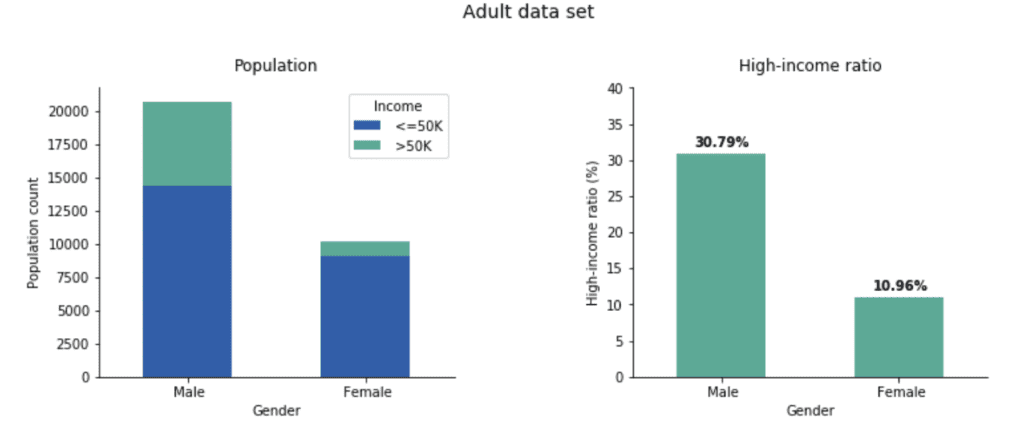
Statistical parity is a very intuitive fairness measure and, in a perfect world with equal opportunities for everybody, it would be satisfied. There are many other, equally viable metrics but keep in mind that there is no single equation or approach that will perfectly fit vastly different scenarios. To truly address and derive actionable insight against bias, one needs a deep understanding of the underlying issues in each use-case. What we developed here is a flexible framework to generate synthetic data that satisfies fairness with respect to a given metric, focusing on parity for now and exploring other measures in a subsequent study.
How To Create A Fair Synthetic Dataset?
There are three points in the machine learning life cycle where you can mitigate bias: at the source, by changing your input data; during the modeling phase by using additional fairness constraints; and as a post-processing step, by revising the algorithm’s decisions in favor of a sensitive group. Naive data-level techniques, such as oversampling methods, have the risk of skewing important data distributions when mitigating imbalances. Our approach is a sort of hybrid, using fairness constraints on a generative model to produce fair synthetic data.
Now, the main objective of our Synthetic Data Platform is to generate new, synthetic data that is as accurate and as representative as the original data set. Under the hood, the software leverages deep neural networks that are trained to optimize an accuracy loss: this simply measures how well our model is reproducing the statistical distributions of the real data. Now, in order to get fair data, we can add a fairness constraint to this optimization step. To stick with the income example, for every mini-batch of data that enters during training, we penalize the violation of statistical parity by a number that is proportional to the difference between the fraction of women and the fraction of men in the high-income segment. We then adapt the model parameters with the objective to minimize both the accuracy loss and fairness constraint.
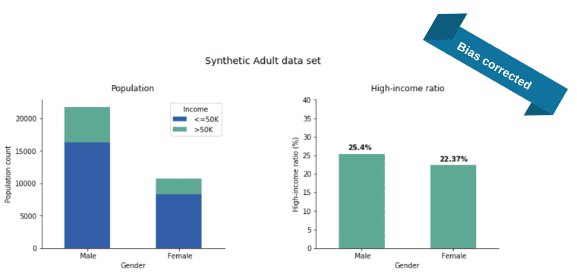
Using this approach, we successfully removed the income inequality with respect to gender from the synthetic version of the Adult data set. We did this with very little compromise on other aspects of data accuracy: for example, you can see we preserved the original Male/Female ratio perfectly.
How Organizations Can Benefit From Private And Fair Synthetic Data
One of our main motivations in working on fair synthetic data generation is the following scenario: imagine Got Big Data Company, a conscientious organization that aims to develop a new predictive model. To do so, they ask the help of a 3rd party vendor, SmartUp AI, and until recently, such collaborations involved allowing access to their sensitive database. Moreover, if Got Big Data Company wanted to address data bias then it required rather special know-how on the developer’s side. Here enters fair synthetic data: Got Big Data Company first generates a synthetic and hence private version of their original data set which is also fair with respect to the modeling task at hand. Next, the vendor, SmartUp AI, develops the predictive model on the synthetic data, just as they would for any task without having to be concerned about bias correction on their end. Then, these models are handed back to Got Big Data Company for use on actual customer data.
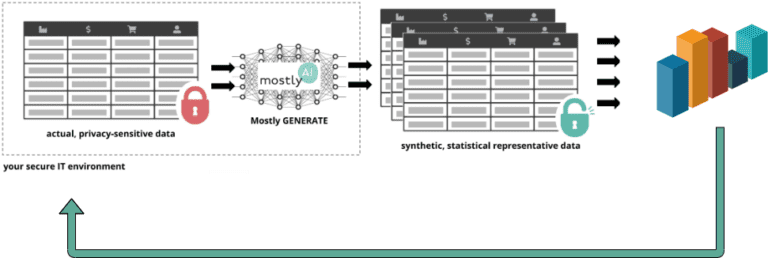
using the synthetic data ⇒ evaluate and deploy on real data.
We find that out-of-the-box predictive models trained on fair synthetic data treat the classes of the sensitive attribute near equally (e.g., female and male). This fair outcome is solely due to using parity-corrected synthetic data, there are no fairness constraints of the predictive models. In the next article, we will release our parity-corrected synthetic data and dive into the technical details of our approach and analysis of the generated data.
Conclusions
There are many inherent risks in automated decision making and in the use of data sets that do not reflect the world we strive to live in. Historical and measurement biases skew predictive models which in turn affect millions of people who are applying for loans or submitting job applications. As data scientists, engineers, and business leaders, we are responsible to address these issues as best as we can. At Mostly AI, we offer a two-in-one tool to utilize data sets that are often sensitive and biased at the same time. First, our fair synthetic data can be safely shared without leaking personal information. Second, having addressed bias-mitigation at the synthetic data generation phase, it enables organizations to utilize existing analytics and modeling pipelines without the need for costly anti-discrimination modifications. To learn more about how fair synthetic data is generated, continue with part 5 of our Fairness Series.
“One of the major challenges in making algorithms fair lies in deciding what fairness actually means,” said Dr. Chris Russell, who is leading the safe and ethical AI group at the Alan Turing Institute, in an interview with Wired. “Trying to understand what fairness means, and when a particular approach is the right one to use is a major area of ongoing research.” Fairness is a vastly complex concept and as people tend to have different values their interpretations of fairness differ as well. A mother might think it is fair if both of her children receive two pieces of chocolate. But instead of having two happy kids eating their chocolate, they start to quarrel. The older ones’ argument? He is much bigger and thus should have received a piece more than his brother. The little one’s opinion? It was him who helped dad do the dishes yesterday evening – therefore he is the one deserving more chocolate. Read the other parts of the series:- Part 1 - Why Bias in AI is a Problem & Why Business Leaders Should Care
- Part 2 - 10 Reasons For Bias In AI And What To Do About It
- Part 4 - Tackling AI Bias At Its Source – With Fair Synthetic Data
- Part 5 - Diving Deep Into Fair Synthetic Data Generation
Equal Treatment Versus Equal Access
In the private as well in the business context we oftentimes strive to achieve fairness by treating everybody exactly the same. An equal amount of chocolate. An equal amount of time to finish a test in school and – in an ideal world – also equal pay regardless of gender or race. The concept behind this is called equality. But what it fails to take into account is that not every one of us starts from the same place and that some might need different support than others do. Imagine three people of divergent height trying to get to the beautifully ripe, red apples on an apple tree. If you were to give a small pedestal to everyone, it would not really improve the situation for the smaller individuals:
Fair AI Requires A Mathematical Fairness Definition
In order to build fair machine learning systems, we need to precisely define and quantify what we mean by a fair outcome. There are several mathematical definitions that do just that and on a high level, these notions fall into two categories: group and individual fairness. Group fairness and parity constraints aim to achieve the same outcomes across different demographics, or more generally, a set of protected population classes. In other words, the population that receives a given assessment by the algorithm (let it be positive or negative) should reflect the whole population and its demographics. We can furthermore require that the types of mistakes the model makes and the severity of these errors should be evenly distributed across the population. These requirements are intuitive, easily applied across domains, and hence are the most widely used, and studied. At the same time, being fair with respect to parity can seem highly unfair from a single individual’s viewpoint. So individual fairness advocates treating similar individuals similarly. The ”Fairness through Awareness” approach is built on first defining a task-specific similarity measure between pairs of data subjects and using that to quantify how close predictions a randomized algorithm should give on two individuals. There are ways to combine group and individual fairness, such as learning fair representations (abstract transformations of the data points into high-dimensional numeric vectors) that could be used in downstream modeling tasks. Yet another approach develops individual risk scores and uses a thresholding policy to treat similarly risky individuals the same way. The list of fairness definitions goes on and on, but in all cases, one aims to find the most accurate model that still satisfies a given fairness constraint. But who exactly selects the protected classes and the requirements that should be met? We know that certain parity requirements are impossible to satisfy simultaneously. On the other hand, finding the right metric and risk scores for individual assessments can be very challenging and needs to be done on a case-by-case basis. As Hanna Wallach from Microsoft Research puts it “[…] issues relating to fairness and machine learning are fundamentally socio-technical, and they are not going to be addressed by computer scientists or developers alone”. So it is of utmost importance to include a diverse set of stakeholders in these decisions with an insight into the whole decision-making process.Demographic Parity – A Group-Fairness Measure
For defining and explaining in more detail group-fairness measures, let’s revisit David Weinberger’s tomato factory example. In this hypothetical factory, tomatoes are processed to end up in spaghetti sauce. An integral part of the factory is a machine learning algorithm that automatically analyzes tomatoes on the conveyor belt and classifies them into fresh and bad (or rotten) tomatoes. Fresh tomatoes are transferred into the “Acceptable” bin and ultimately end up in the spaghetti sauce, rotten tomatoes end up in the “Discard” bin and are thrown away. Consider there exist only two kinds of tomatoes worldwide: 80% of all tomatoes are red tomatoes and 20% of them are yellow. Apart from their appearance, there is no difference between red and yellow tomatoes. They taste the same, have the same shape, grow equally fast, and need equal amounts of care. They also have the same storage life which means they start to rot after the same time span. One of the most intuitive definitions of fairness is demographic (or statistical) parity. In case the tomato sorting machine learning algorithm satisfies demographic parity, we expect about 80% of red and 20% of yellow tomatoes within the “Acceptable” bin in the spaghetti factory. In other words, we expect the fractions of red and yellow tomatoes in the global population to be reflected in the “favorable” group of “Acceptable” tomatoes in the factory. An unfair algorithm, that “favors” red tomatoes and discriminates against yellow ones, would put more than 80% of red tomatoes in the “Acceptable” bin. In this example, demographic parity is a perfectly fine measure. However, as Dwork and co-workers pointed out, the notion of demographic parity has shortcomings and needs to be applied with great care. Imagine that our two hypothetical tomato sorts do differ in that yellow tomatoes tend to rot a little faster than red ones on their way to the factory. In that case, the fraction of red tomatoes in the “Acceptable” bin should be larger than 80% as more of the yellow tomatoes need to be discarded. Enforcing demographic parity in this scenario leads to two problems. First, it actually introduces some unfairness. To achieve demographic parity, say for a one-day batch of tomatoes processed in the factory, the algorithm needs to put some rotten yellow tomatoes into the “Acceptable” bin while, at the same time, prevent some of the perfectly fresh red tomatoes from going in there. The second shortcoming is related to the tension between accuracy and fairness. If the tomato sorting algorithm was what is called a perfect classifier (in practice a perfect classifier does not exist but for the sake of the argument let’s consider it does), it would not make any mistakes and place all tomatoes in the correct bin. As such, this algorithm is fair as it treats every single tomato the way the tomato “deserves”. Enforcing demographic parity on this perfect classifier would actually detune it – which clearly shows that there is a misalignment between optimizing a classifier and satisfying demographic parity. Therefore, demographic parity usually leads to larger costs in accuracy and, therefore, costs an organization more money than other fairness measures.Equality of False-negatives And Equalized Odds
The core problem of demographic parity is that it does not take into account the ground truth. It does not care whether or not tomatoes are “Acceptable”, it just requires the fractions of red and yellow tomatoes in the global population being represented in the “Acceptable” bin. There is a group of fairness measures that do take into account the ground truth by, for example, balancing or equalizing the errors the sorting algorithm makes for both sorts of tomatoes. One of the simplest examples in this context is the so-called equality of false-negatives measure that enforces constant false-negative rates across groups. In our tomato example, this means that fresh tomatoes – irrespective of their color – have the same probability of falsely ending up in the “Discard” bin. This measure only amends the errors made in the group of fresh tomatoes as only they can falsely end up in the “Discard” bin. An even stronger fairness notion that also mitigates errors in the group of rotten tomatoes is called equalized odds. It requires constant false-negative as well as true-negative rates across groups. This means that also the chances for rotten tomatoes ending up in the “Discard” bin is equal for red and yellow tomatoes. One big advantage of these types of fairness measures is that they allow for perfect decisions. For a perfect classifier, the false-negative and true-negative rates across all groups are 0% and 100%, respectively. This does not mean that the accuracy of a real-world classifier is not limited by an additional fairness constraint but it shows that, for example, equalized odds is usually better aligned with optimization than demographic parity.The Accuracy Versus Fairness Trade-Off
Fairness always comes at a cost: as we put an additional constraint on the model, we introduce a trade-off with accuracy. This is not a new phenomenon and a stark example relates to a fatal Uber accident in Tempe, Arizona. The autonomous vehicle system detected the pedestrian in time to stop but the developers had tweaked the emergency braking system in favor of not braking too much, balancing a trade-off between jerky driving and safety. Going back to bias, when we compare a model that maximizes total revenue, a fairness constrained model will probably promise less profit. You can explore these concepts with an interactive threshold classifier, including demographic parity and equal opportunity (that is, equal true positive rates), in a post from Google Research. By setting various global or group aware thresholds for giving out hypothetical loans, you can see how the bank’s profit and the distributions of loans across the population changes.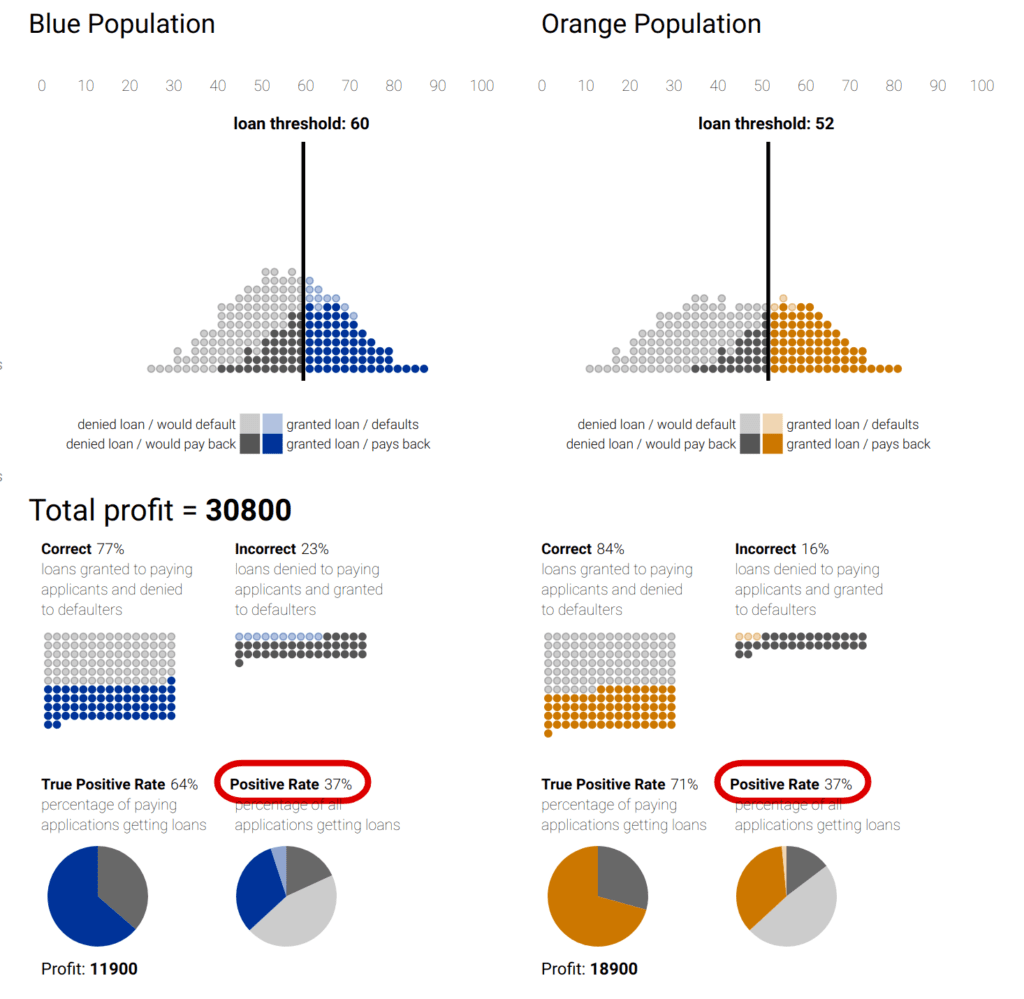
Call for action
We have seen that there are numerous differences between fairness definitions and one is not necessarily better than the other. In our forthcoming posts about fair synthetic data, we shall focus on group fairness and on statistical parity first. But before that, we are curious: how does your company approach fairness in AI? Do you have measures in place already or are you just starting to evaluate possible data bias and your modeling pipelines? If so, what resources do you consider most useful and what resources do you wish you have? We would love to hear your thoughts. You may remember that back in 2015 Google was called out for its photo app that mistakenly labeled pictures of people with darker skin color as “gorillas”. As you can imagine, it was a PR disaster back then. Of course, the company publicly apologized, said that such a result is unacceptable and promised to fix the mistake. But apparently – as Wired uncovered three and a half years later – they somehow never got to truly fixing the underlying issue. What they did is, they implemented a workaround: by blocking their AI from identifying gorillas (and some other primates) altogether to prevent another miscategorization. A Google spokesperson confirmed to Wired that certain image categories were and remained blocked after the incident in 2015 and added that “Image labeling technology is still early and unfortunately it’s nowhere near perfect”. But what does this mean for other companies and their chances for success in fighting bias in AI? If one of the biggest tech companies – that employs some of the brightest AI experts – was not able to come up with a better solution? Firstly, it definitely proves the point that it is extremely difficult to mitigate bias in machine learning models. Secondly, it may raise the question of whether Google really was not capable of resolving the issue, or whether they just were not willing to dedicate the necessary resources? But before we look into how companies could tackle bias in Artificial Intelligence (and whether AI regulations could be the motivational factor to do so), let us start with a (non-exhaustive) list of reasons why algorithms are biased.Read the other parts of the series:
- Part 1 - Why Bias in AI is a Problem & Why Business Leaders Should Care
- Part 3 - We Want Fair AI Algorithms – But How To Define Fairness?
- Part 4 - Tackling AI Bias At Its Source – With Fair Synthetic Data
- Part 5 - Diving Deep Into Fair Synthetic Data Generation
Reason #1: Insufficient Training Data
As mentioned in part 1 of our Fairness Series, a major problem of bias in AI is that not enough training data was collected. Or more precisely, that only limited data for certain demographic groups or groups with extraordinary characteristics is available. The consequences of insufficiently diverse data can easily be observed with facial recognition technology. A study showed, that models performed significantly better on pictures of white males (99% accuracy) versus black females (65%), because the majority of images used in model training consisted of white men.Reason #2: Humans Are Biased – And So Is The Data That AI Is Trained On
Whether we like it or not, as humans we all carry our (un)conscious biases that are reflected in the data we collect about our world. As this is the exact same data that is used to train AI models, it is not surprising that these biases find their way into algorithms. Imagine a hiring algorithm that is trained on existing U.S. employment data. Last year, women accounted for only 5% of CEOs in the top 500 companies. They also held significantly less senior management positions than their male co-workers. What would this mean for the algorithm? Quite likely, it would pick up that being female correlates poorly with being a CEO. And if hiring managers were to look for the ideal candidate to fill an open senior management position, the system will probably mainly show the resumes from male applicants. Another common problem with human bias occurs in the context of supervised machine learning, where humans oftentimes label the data that is used to train a model. Because even if they are well-intentioned and not mean any harm, their unconscious biases could sneak into the training sample.Reason #3: De-Biasing Data Is Exceptionally Hard To Do
If you wanted to have a fair algorithm – but we have just established that historical data is biased – what if you would clean the data to make it fair? One approach that has been tried is removing sensitive attributes. For example, a person’s race. Unfortunately, research has shown that this does not prevent models from becoming biased. Why? Because of correlated attributes that can be used as proxies. Think about a neighborhood that is known to be home to predominantly black people. Even if the race-column would have been excluded from the training data, the ZIP code of this neighborhood would serve as a proxy that indicates the race of a person. It has been shown, that even if sensitive columns were removed, proxies allowed for systematic discrimination of minorities. For example, the denial of bank loans or access to Amazon’s same-day purchase delivery option. To counteract this, some researchers advise to actually keep the sensitive columns in the dataset, as they could serve as a more straightforward lever to mitigate data bias. For example, if you aim for a model that treats males and females equally, you can use the gender-column to directly monitor and correct for potential violations of your desired equality criteria during model training.Reason #4: De-Biasing AI Models Is Very Difficult Too
There is a multitude of reasons why it is difficult to develop a machine learning model that is free of bias. One aspect to consider is that there are many decisions involved in the construction of a model that could potentially introduce bias – but the downstream impacts of them oftentimes do not become apparent until much later. For example, the choices AI researchers made in regards to how speech was analyzed and modeled led to the outcome that a speech recognition algorithm performed significantly worse for female speakers as opposed to male ones. Another aspect that has been criticized is that common practices in deep learning are not designed to help with bias detection. Because even though models are usually tested before they are deployed, this oftentimes happens with a holdout sample from the training dataset. While this certainly helps with the evaluation of an algorithm’s accuracy, it does not help with bias detection since the data that is used for testing is as biased as the data that is used during the training. Lastly, building an unbiased model requires expert knowledge that not every AI engineer may have obtained (yet). Especially as more and more “off the shelf”-algorithms become available nowadays, that can be used by non-experts, this becomes an additional point of concern.Reason #5: Diversity Amongst AI Professionals Is Not As High As It Should Be
Lack of diversity is another contributing factor to bias in AI: At Facebook and Google less than 2% of technical roles are held by employees with darker skin color – and women account for only 22% of AI professionals globally. A famous example of why diversity helps to mitigate bias comes from Joy Buolamwini, founder of the Algorithmic Justice League and graduate researcher at the MIT Media Lab. When the Ghanaian-American computer scientist joined her research group, she discovered that facial recognition tools performed poorly on her darker skin tone – and sometimes only worked if she wore a white mask. Another quite peculiar incident that can be attributed to non-diversity happened to a South Korean woman, who was sleeping on her floor until a robotic vacuum cleaner “attacked” and ingested her hair. Rest assured that firefighters managed to rescue her (minus about 10 strands of her hair). But if the product development team would have consisted of a more diverse group of people – with different cultural backgrounds – somebody might have raised the question of whether all future users tend to sleep in beds. But if something is not part of a person’s reality it is hard to think about it, consider it, and ask the necessary questions.Reason #6: Fairness Comes At A Cost (That Companies May Not Be Willing To Pay)
Depending on what is most important for a company that is developing an AI algorithm, it could either optimize the model to maximize the profits, to increase the revenue or the number of customers. No matter what they decide on, their main objective will be to improve the model’s accuracy. However, what would happen if the company decided that it wanted to have a fair model as well? Then the model would be forced to balance two conflicting objectives. Achieving fairness would inevitably come at the cost of maximum accuracy. In our economy companies often tend to optimize for profit. Thus, it can be put into question how many businesses would voluntarily decide to take the path of fairness or whether regulations would be required to “persuade” them?Reason #7: External Audits Could Help – If Privacy Would Not Be An Issue
Especially in scenarios where AI applications are used in high-stake environments, voices were being raised that external audits should be used to systematically vet algorithms to detect potential biases. This may be an excellent idea – if privacy would not be an issue. To thoroughly evaluate an algorithm not only access to the model but also to the training data would be beneficial. But if a company would share the privacy-sensitive customer data it used to develop its model, it would quickly get into conflict with GDPR, CCPA, and other privacy regulations. However, synthetic data – a new approach to big data anonymization – could provide a solution for this issue. Synthetic data tools allow to generate fully anonymous, yet completely realistic and representative datasets. Their high accuracy enables an organization to directly train its machine learning models on top of it, while the strong privacy protection properties allow to externally share synthetic datasets with auditors without infringing people’s privacy.Reason #8: Fairness Is Hard To Define
In the 1970s only 5% of musicians in the top five orchestras were female. Blind auditions increased the percentage of women to 30%, which certainly is an improvement – but many people would agree that this is not yet fair. However, it would be much harder to reach an agreement about what would be fair. Should there be 50% of women in the orchestra, because roughly half of our world’s population is female? Or would it be fairer if the same percentage of female, as well as male applicants, get accepted? For example, 20% each. Considering that many modern orchestras employ approximately 100 full-time musicians, this could mean that 40 seats get to female musicians and 60 to male ones (if 200 women and 300 men were to apply). Others might argue that due to centuries of injustice (and overrepresentation of male musicians in orchestras) employing significantly more women would be fairest. As you can see, it is pretty hard to define fairness. One reason is that different people have different values. Another one is that there are so many different ways to define fairness – in general, as well as mathematically (Arvind Narayanan, an associate professor of computer science at Princeton, even compiled an astonishing list of 21 fairness definitions).Reason #9: What Was Fair Yesterday Can Be Biased Tomorrow
Do you remember Microsoft’s “Tay”? The innocent AI chatbot started as a harmless experiment and was intended to learn from conversations with Twitter users – which it did (but probably not as imagined). In less than a day, Tay became misogynistic and racist:
Reason #10: The Vicious Bias Cycle (Biased AI Will Lead To More Bias)
If bias in AI is not successfully addressed, it will perpetuate and potentially even amplify biases in our society. A good example of this is Google’s search algorithm that was accused of showing racist images. When users searched for terms like “black hands”, the algorithm predominantly showed pictures of black hands working in the earth and other derogatory depictions. It can be assumed that more users will click on the top search results as opposed to potentially more neutral images which are not shown on the first page. Consequently, the algorithm is much more likely to display them more often and thus would further contribute to perpetuating biases.How To Achieve Fairness In AI?
In November 2019 a Danish Apple Card user uncovered that Apple’s AI algorithm granted him 20 times the credit limit that his wife received. This disparity came as a major surprise as the couple shared assets and she actually had a higher credit score than he did. Apple and Goldman Sachs, who partnered on this financial product, repeatedly assured that this wasn’t a case of discrimination. But what started with a viral tweet brought more and more cases of bias to the surface – and ultimately led to an investigation by the New York State Department of Financial Services.
Yet another high-profile issue was investigated by ProPublica: An algorithm used by the US’ criminal justice system that predicts the risk of defendants to re-offend once they have served their sentences. Based on the algorithm’s results, judges determine which defendants are eligible for probation or treatment programs. In ProPublica’s study, the authors demonstrate that the algorithm is biased with respect to ethnicity:
Afro-Americans are almost twice as likely as whites to be labeled a higher risk but not actually re-offend. It [the algorithm] makes the opposite mistake among whites: They are much more likely than blacks to be labeled lower risk but go on to commit other crimes
While Artificial Intelligence has remarkable potential to analyze and identify patterns even in very large datasets and to help humans to make more informed decisions, the examples mentioned above were by far not the only incidents where customers or researchers are concerned about machine learning models exhibiting discriminatory behavior based on gender, race or sexual orientation.
Read the other parts of the series:
- Part 2 - 10 Reasons For Bias In AI And What To Do About It
- Part 3 - We Want Fair AI Algorithms – But How To Define Fairness?
- Part 4 - Tackling AI Bias At Its Source – With Fair Synthetic Data
- Part 5 - Diving Deep Into Fair Synthetic Data Generation
But Why Is AI Biased?
Simply spoken, there is not one root cause for bias in AI – and that is why it is so difficult to get rid of it. One of the major problems is insufficient training data where some demographic groups are missing or underrepresented. For example, one study by MIT researchers revealed that facial recognition technology had higher error rates for minorities – particularly if they were female. Another study found, that a facial recognition system was 99% accurate in detecting male faces, but was only capable of correctly recognizing a black woman two out of three times. This difference in performance originated from the dataset that was used to train the model: there were 75% male faces but only 25% female ones in the training sample and 80% of the total amount of images showed white persons. Naturally, the algorithm better learned to identify those categories where significantly more data was available.
Similar issues can be observed when AI is used for recruiting purposes without making sure that a substantial amount of training data, for a diverse group of people, is used during model training. Thus concerns have been raised, that for example remote video interview software that evaluates employability based on facial expression, speech patterns, and tone of voice could unfairly disqualify disabled people. Possibly even more concerning (and potentially fatal) are scenarios where AI is applied for healthcare. One example is the British health app “Babylon” that was accused of putting female users at risk. It suggested that sudden pain in the left arm and nausea may be due to depression or having a panic attack and advised women to go see a doctor in the next few days. In contrast, males showing the same symptoms were advised to immediately visit an emergency department based on the diagnosis of a possible heart attack.
According to Prof. Dr. Sylvia Thun, director of eHealth at Charité of the Berlin Institute of Health, “there are huge data gaps regarding the lives and bodies of women”. In a recent Forbes interview, she explained that medical algorithms are oftentimes based on U.S. military data – an area where women, in some cases, only represent 6% of the total personnel. Thus she emphasized the importance of making sure that medical apps take relevant data not only from men but also from women into account.
Bias In Artificial Intelligence Is A Human-made Problem
However, AI bias is not always a consequence of limited training data. To a certain extent, all humans carry (un)conscious biases and behave accordingly. Thereby our human biases find their way into the historical data that is used to train algorithms – and thus it is not surprising that they get picked up by machine learning models. An example for this was at one point Amazon’s recruiting algorithm that learned that – historically – the majority of technical roles was filled by males and thus penalized a resume if it included the word “women”. Or Google’s discriminatory job ads algorithm that disproportionately showed high-paying job ads to men but not to women.
Another example comes from the U.S. health care system where AI is deployed to guide healthcare decisions. A study found that a widely used algorithm discriminated against black people by estimating the level of care that is needed based on health costs. Due to the fact that more money is spent on white patients, the algorithm concluded that black patients are healthier and don’t require the same amount of extra care.
Avoiding Artificial Intelligence Won’t Eliminate Discrimination
Human bias in historical data is an issue that needs to be addressed when developing AI algorithms. But it also makes apparent that simply refraining from applying AI in our day-to-day lives wouldn’t solve our society’s problem of discrimination and unfair treatment of minorities. Long before AI found its way into today’s economy, researchers documented cases of injustices due to race, gender, or sexual orientation. From hiring managers, that invited people with white- instead of black-sounding names 50% more often to a job interview. To women, who in general are 47% more likely to suffer from a serious injury and 17% more likely to die in a car accident, because seatbelts and other safety features in cars were designed based on crash test dummies with male physiques.
In fact, quite the opposite might be true: As AI algorithms require us to be completely clear and to precisely define which outcomes we would consider fair and ethically acceptable, there might be the inherent potential that this new technology will enable us to better mitigate bias in our society. This rationale is also shared by Sendhil Mullainathan, Professor at the University of Chicago, who authored several studies on bias (in people and in AI). In a recent New York Times article he stated that:
Changing algorithms is easier than changing people: software on computers can be updated; the “wetware” in our brains has so far proven much less pliable. None of this is meant to diminish the pitfalls and care needed in fixing algorithmic bias. But compared with the intransigence of human bias, it does look a great deal simpler.
Why Should Business Leaders Care About Bias in AI?
As a society, we should strive to develop AI technology that is effective and fair for everyone. But also businesses – which will become increasingly more reliant on machine learning algorithms – will benefit if they proactively tackle bias in AI. One of the more obvious advantages is, that the mere idea of an underlying algorithm being biased could be enough to turn customers against a product or a company. Moreover, having researchers expose the discriminatory nature of a proprietary AI application constitutes a significant reputational risk that could be hard to recover from.
Another point to consider is that developing an algorithm that accurately performs on the whole spectrum of human diversity is also much more likely to deliver superior value to a broader and varied group of potential customers. But not only customers would benefit from unbiased AI. According to Gartner, “By 2022, 85% of AI projects will deliver erroneous outcomes due to bias in data, algorithms, or the teams responsible for managing them. This is not just a problem for gender inequality – it also undermines the usefulness of AI”.
Ultimately, the ongoing discussion about anti-bias regulations, the issued Ethical AI guidelines and the call for AI certifications could be motivating factors to approach this topic proactively. Especially since the European Commission emphasized the importance of having “requirements to take reasonable measures aimed at ensuring that [the] use of AI systems does not lead to outcomes entailing prohibited discrimination.” in their white paper on Artificial Intelligence, which was just released in February 2020.
This was part 1 of our Fairness Series. Tomorrow’s post will cover 10 reasons why AI algorithms are biased and what you can do about it. On Wednesday, we will take a deep-dive into the definition of fairness and discuss how it can be balanced with other values. We are already very much looking forward to Thursday, where we will introduce the brand new concept of Fair Synthetic Data (which is bias-corrected, fully anonymous data that is free to use and innovate with). This is followed by Friday’s post, which will be the technical centerpiece of this series. There you will learn more about Fair Synthetic Data Generation – and if you are interested, we will also share two fair synthetic datasets with you to experiment on. So make sure that you don’t miss out!